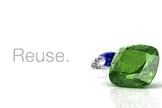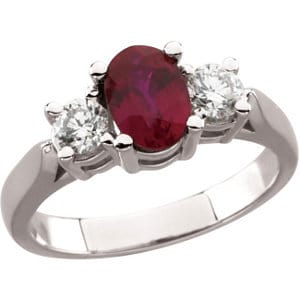Well the top three hardest are Diamond, Sapphire and Ruby, and an easy way to remember is: red-white & blue stones!
The hardness of a gemstone is measured on its place on Mohs scale of hardness. 10 on Mohs scale being the hardest known naturally occurring substance– and the honor goes to the diamond.
The Moh’s scale was devised in 1812 by Austrian mineralogist, Friedrich Moh, to measure a mineral’s hardness and its resistance to scratching. The scale goes from talc as number 1, being the softest, to diamonds as number 10, being the hardest substance known.
Most faceted gems are in the range of 7 to 9 on Mohs scale.
Some softer minerals are also used for gems because of their intense colors and patterns, but gems below 6 in hardness must be treated with care.
A gemstone’s ability to withstand daily wear in jewelry without damage is significant and will affect value. Generally, a harder gemstone will endure best since it will be able to withstand being scratched.
It is important to know a gemstone’s hardness to determine practicality and desirability for lasting jewelry. Overall hardness ranks as one of the most important characteristics for jewelry toughness, especially with transparent, faceted, precious and semi-precious stones.
Naturally, there are several elements to consider when determining a gemstone’s overall qualifications for jewelry – brittleness, flaws, cracks, or reaction to changes in the environment, to name a few. Yet, overall mineral hardness ranks tops when ranking durable gems.
Knowing a gem’s relative hardness helps with purchasing decisions, as well as decisions relating to jewelry wear, care, cleaning, and storage.
Here are the top 10 gemstones in order of Hardness*
1. Diamond – Diamond is the hardest natural element know to man. Even
if we know harder materials, they are man made. The diamond is the
hardest and the most durable gemstone of all.
2. Sapphire – also called Corundum, is a very hard, tough, and stable
mineral that encompasses many colors, although the most popular and
valued color of Sapphire is blue. Sapphire is also only used to
describe the gem variety; it is the second hardest mineral after the
Diamond. It is unaffected by acids and most environments.
3. Ruby – is the red variety of the mineral corundum; Ruby and
Sapphire are scientifically the same mineral but just different colors.
4. Emerald
5. Alexandrite
6. Topaz
7. Spinel
8. Zircon (CZ)
9. Garnet
10.Aquamarine
*note the scale is not quite proportional, as the Diamond (ranked #10) is actually four times harder than Corundum (Ruby and Sapphire) which are ranked at #9















